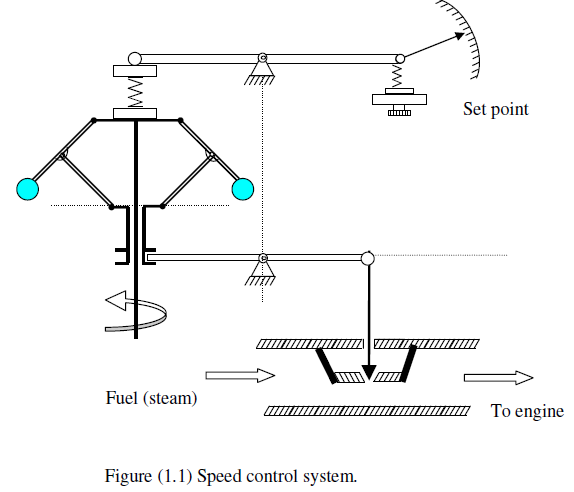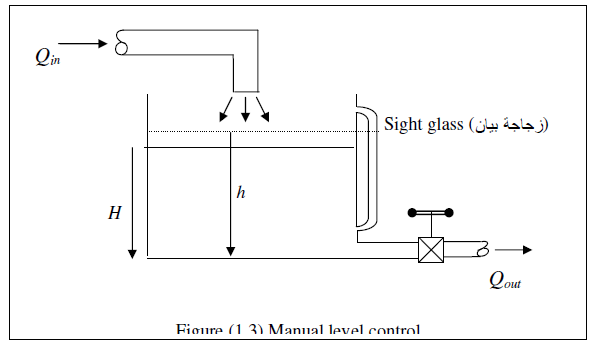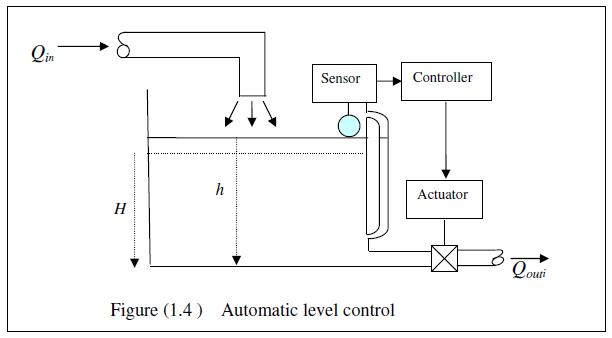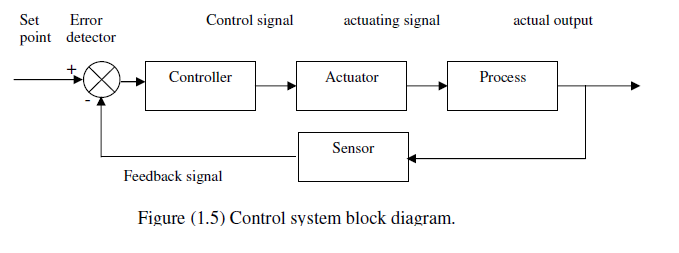Main keywords for this article are Feedback Control – Levels of Control Engineering – Process Control Principles. Automatic Control. Process Control Block Diagram. Advantages of Automation.
Feedback Control
Automation is used in many engineering systems. It is used to improve the operation of devices to do functions that can never be done by human operator because of the required:
• Speed, Precision, Power and economical operation.
Modern automation started with the invention of steam engine.
Example of early automatic control mechanism is the speed governor, as shown in figure (1.1).
Most early automatic control systems were self-operating, which means that there is no external source of power is required to drive the controller. A simple example is the float-controlled valve to control the water level, as shown in figure (1.2).
In modern controllers, we use electrical, hydraulic or pneumatic transmission of signals to control the process.
Advantages of Automation
a- Fuel saving “due to efficient operation”.
b- Reduced maintenance, because of efficient operation and timely warning of defects.
c- Personal saving, less number of individual is required.
c- Improved environment, watch keeping in a comfortable control rooms.
e- Increased safety, the degree of human error is less
Automation Disadvantages
1- Increase first costs.
a- Extra components.
b- More sophisticated and expensive components and devices are employed.
c- Skilled persons are required to install and test the components.
d- High degree of design work.
2- Increased running costs, as extra costs are involved to provide
a- Power required to operate the controls.
b- Staff education costs
c- Extra maintenance may be required.
Levels of Control Engineering
Application of control engineering in marine field has increased steadily during the last few years. The levels vary between very simple system to most complicated and sophisticated systems. These levels are:
1- Centralized instrumentation in the engine room. (Display)
2- Data logging and alarm systems (ON -OFF Control)
3- Remote automatic control.
4 – Computer application.
Centralized Instrumentation in the Engine Room.
Initially instruments were distributed all around the engine room. Watch keeping engineers , in addition to attending the maneuvering platform had to do a periodic round to check the operation of various machinery.
Data Logging and Alarm Systems.
The next logic step is to put these instruments in a separate air conditioned control room.
The system provides:-
• Centralized display.
• Recoding.
• Alarming.
• Remote control.
Important variable such as temperature, pressure, level etc. are scanned and monitored. Also remote control of the maneuvering valve may be provided.
ON -OFF normal operation is indicated by an alarm system which gives visual and audible signal in the important parts of the ship such as the bridge, control room, engineer’s accommodation , etc…
Automatic Control
Fully automated engine rooms are developed to reduce the number of crew. In a so called “unmanned watch”. The night watches are completely unattended. In the day work the crew carries the maintenance work. The crew is considered as stand-by in case of an emergency.
Computer System for Ship Applications
A ship may be provided with computer, which performs many functions such as:-
– Automatic control of the engine room.
– Navigation.
– Cargo handling (load master).
– Ship management…etc.
Process-Control Principles (Johnson)
In process control, the basic objective is to regulate the value of some quantity. To regulate means to maintain, that quantity at a desired value regardless of external influences. The desired value is called the set piont .
The control process may be manual control or automatic control.
Manual Control
Consider the liquid level control process shows in figure (1.3).
The objective is to regulate the level at a desired value, the set point H. the level, is called the controlled variable.
The main parts of the process are:-
– A tank with sight glass S.
– A valve to change the output liquid flow by the human.
The human measures the actual level h in the sight glass and compares it with the set point H. if h > H, the human opens the valve to increase the output flow Qo, the water level h lowers till h =H. If h < H, the human closes the valve to decrease the output flow Qo, and allow the level h to rise till h =H. So by continuous monitoring of the sight glass the human can bring the water level h to the set point H.
Automatic Control
To provide automatic control , the system is modified as shown in figure (1.4), the human is replaced by the following devices:-
– Sensor: To measure the water level and generates a signal S that represents that level.
– Controller: It compares the set point H with the actual level h and generates a control signal u to change the valve opening via an actuator.
– Actuator: Is connected to the valve by a mechanical link.
Process Control Block Diagram.
Each element in the system is represented by a block as show in figure (1.5).
The basic elements are:-
– Process: The tank and the liquid.
– Sensor: Measures the level and converts it into an electrical or pneumatic signal.
– Error detector: A part of the controller to compare the set point H with the actual level h.
– Controller: A decision making device, it generates a control signal.
– Actuator: The final control element, the device that has a direct on the process and changes the controlled variable to bring it to the set point .




